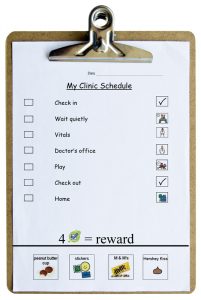Section 6: Practical Strategies across Settings
83 Visual Supports: Introduction
 Why do we utilize visual strategies with individuals with ASD?
Why do we utilize visual strategies with individuals with ASD?
Many caregivers of individuals with ASD become frustrated when teaching them new skills. Individuals with ASD may have trouble learning new skills because they do not learn the same way as others do. Individuals with ASD learn best through visual information. They also prefer information that relates to their interests. Unlike their peers, they may not easily learn by watching and copying others, or by being told what to do.
Individuals with ASD are also easily over-stimulated. They need tools to help them make sense of the information they receive. Once given these tools, even anxious or highly prompt-dependent children can begin to do more for themselves.
 Why is visual information much easier for individuals with ASD to process?
Why is visual information much easier for individuals with ASD to process?
Visual structure and tools can provide a sense of routine and structure to anyone. Many learning environments can be overly stimulating because they have so much to see, hear, and touch. With all of this input, individuals may get easily distracted or have a hard time focusing where needed. In any setting, information may come from a number of people or cues, making expectations confusing and further overwhelming the individual. The response from the individual may be to engage in repetitive or other behaviors or attempts to maintain any sense of sameness and consistency, and control. Visual information can provide that sense of clarity, structure, routine and predictability needed .
Visual information is of further benefit in that it remains present as long as the individual needs it, unlike verbal input which is provided and then disappears. Visual information allows for longer processing times. When visual information is utilized well, individuals can be more flexible and adapt to changes in that they are less dependent on prompts from others, relying upon the consistent use of the visual tools and supports which enable greater independence.
Can anyone with ASD benefit?
Individuals with ASD who are highly verbal and intelligent can also benefit from visual strategies. These individuals will also tend to have some difficulty in processing verbal information and in organizing and planning their responses. We all benefit from use of visual strategies in our daily lives to enhance predictability and understanding. For example, consider the lists, labels, calendars and other supports that you use daily for basic planning and organization. The precise format and content of these visual strategies may change over time to meet particular needs for support, but remain essential for problem solving, learning and success in everyday life.
